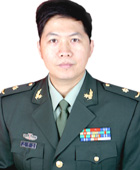3 讨论
本实验中的50 例胃癌组织中有10 例, 约占20% , 出现了同一肿瘤内细胞形态、功能的异质性.同一肿瘤内既有低分化腺瘤细胞, 又存在粘液细胞癌. 有的肿瘤细胞表达V EGF, 有的则不表达, 有的肿瘤细胞既表达V EGF, 同时又表达其受体KDR.肿瘤细胞的这种异质性和多药耐药性为肿瘤的化学药物治疗带来了诸多不便. 本实验发现50 例胃癌中有50% 的胃癌组织表达V EGF. 且V EGF 的表达在肿瘤的生长、进展、转移过程中有着重要作用. 这就为所有固体瘤的治疗寻找共同靶点露出了希望. 50例胃癌中有2 例胃癌组织的肿瘤细胞在表达V EGF的同时, 也表达其受体KDR. 肿瘤组织内及周围组织的血管内皮细胞表达高水平的KDR, 提示, V EGF主要以旁分泌的形式对胃癌的生长、进展、转移起着促进作用. 也可能存在着肿瘤细胞的自分泌形式. 这点还需要进行V EGF, KDR 及V EGF 的另一个受体F lt21 的mRNA 水平的联合检测以及体外细胞增殖学试验来进一步证实. 关于V EGF 以自分泌的形式刺激肿瘤细胞的增殖已在A IDS2KS 细胞和黑色素瘤细胞等肿瘤中被发现[ 1~ 3 ] .

图1 胃腺癌组织中V EGF 的免疫染色, 示阳性物质定位于胃癌细胞胞浆和胞膜F ig 1 Immunoh istochem ical staining fo rV EGF in adenocarcinoma t issues of the stomach. The po sit ive signalw as foundmainlyon the surface and in the cytop lasm of gast ric cancer cells. (o riginalmagnificat ion ×400)
图2 胃腺癌组织中F lk21?KDR 的免疫染色, 示阳性物质定位于胃癌细胞胞膜和胞浆F ig 2 Immunoh istochem ical staining fo r F lk21?KDR in adenocarcinoma t issues of the stomach. The po sit ive signal w as foundmainly on the surface and in the cytop lasm of gast ric cancer cells. (o riginalmagnificat ion ×200)
血管生成的启动是胚胎发育过程中最重要的基本生命现象, 而在生物成体组织中几乎消失. 在女性生殖周期和伤口愈合过程中, 这一现象又复出现,但此现象的复出是瞬时的, 且受严格的生理性机制调控. 当机体出现增殖性视网膜炎及肿瘤等特征性病理改变时, 这一生命基本现象再次重复且持续存在.其中最重要特征是血管内皮细胞的持续性增殖[ 4 ] .肿瘤组织中的内皮细胞增殖指数为10% , 然而正常组织中的内皮细胞增殖指数仅为0. 1%. 肿瘤细胞分泌的V EGF 既可直接、有选择地作用于血管内皮细胞, 刺激其生长[ 5, 6 ] . 也可通过增加血管通透性, 使包括许多基质形成重要因子的血浆蛋白外渗, 促进血管生成[ 7, 8 ] . 由此预测, 抑制肿瘤细胞分泌V EGF 或阻断V EGF 与其受体的作用必将为肿瘤的治疗提供新的共同靶点. 这样既可克服由于肿瘤细胞异质性及肿瘤多药耐药性对肿瘤化疗所带来的不便, 又可更有效地防止肿瘤的生长、进展及转移. 关于这一领域的研究已显示了良好的开端[ 9~ 11 ] 。
参考文献
1Mo sood R, Cai J , Zhang T et al. V ascular endo thelial grow th fac2to r?vascular permeability facto r fo r A IDS2Kapo si Sarcoma. P roN atl A cad S ci USA , 1997; 94 (3) : 979- 984
2 Q uong RY, Bickfo rd ST, Ing YL et al. P ro tein Kinase in no rmaland transfo rmed melanocytes. M elanom a R es, 1994; (5) : 313-319
3 L iu B, EarlltM ,Baban D et al. M elanoma cell lines exp ress V EGFrecep to r KDR and respond to exogenously added V EGF. B iochemB iop hy R es Comm un, 1995; 217 (3) : 712- 717
4 P late KH, Breier G, R isauW. Mo lecular mechanism s of develop2ment and tumo r angiogenesis. B rain P athol, 1994; 4 (3) : 207 -218
5 L eung DW , Cach ianes G, Kuang WJ et al. V ascular endo thelialgrow th facto r is a secreted angiogenic m itogen. S cience, 1989;246: 1306
6 Conno lly DT, Heavelman DM , N elson R et al. Tumo r vascularpermeability facto r stimulates endo thelial cell grow th and angio2genesis. J C lin Invest, 1989; 84: 1470- 1478
7 D ro rak HF, O renstein N S, Carvaiho AC et al. Induction of a fib2rin2gel investment: an early event in line 10 hepatocarcinomagrow th mediated by tumo r2secreted p roducts. J Imm unol, 1979;122: 166- 174
8 Senger DR, Conno lly DT, V an De water L et al. Purification and
NH22term inal am in acid sequence of guinea p ig tumo r secreted vas2cular permeability facto r. Cancer R es, 1990; 50: 1774- 1778
9 Ramak ishnan S, O lson TA , Bautch VL et al. V ascular endo thelialgrow th facto r2toxin conjugate. specifically inh ibits KDR?f lt21 2p ro sitive endo thelial p ro liferation in vitro and angi2ogenesis in v i2vo. Cancer R es, 1996; 56 (6) : 1324- 1330
10 Kendall RL , Thomas KA. Inh ibition of vascular endo thelialgrow th facto r activity by an endogenoully endocoded so luble recep2to r. P ro N atl A cad S ci USA , 1993; 90: 10705- 10709
11M illauer B, Shawer L K, P late KH et al. Glioblastoma grow th in2h ibited in v ivo by a dom inant2negative flk21 mutant. N atu re,1994; 367: 576- 579


























